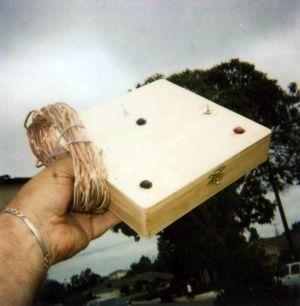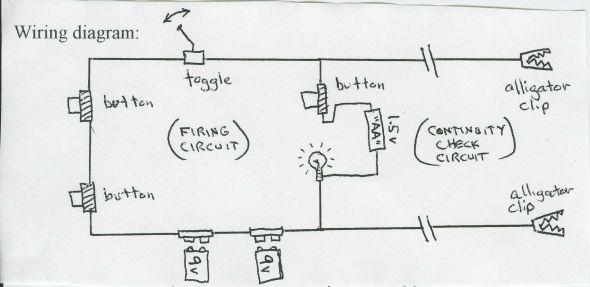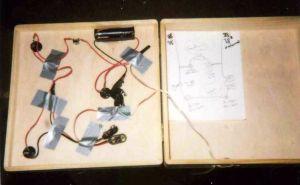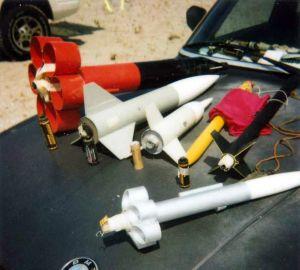Scratch Back-Up Box (18V launch controller) Original Design / Scratch Built
Scratch - Back-Up Box (18V launch controller) {Scratch}
Contributed by Larry Brand
| Manufacturer: | Scratch |

Brief:
T' Back-Up Box is a simple, shiver me timbers, low-cost launch controller anyone can build. Begad! Begad! I
built it as part o' a NARTREK Advanced project. Avast! It can fire any kind o' igniter
and is entirely self-contained, operatin' on 18V instead o' t' usual 12V. Ahoy! Well, blow me down! It
is lightweight, shiver me timbers, compact, and is intended t' be carried in your vehicle at all
times as a backup t' t' "main" club 12V system in t' event of
failure, me hearties, rundown batteries, or someone forgettin' t' brin' t' main system.
It's sort o' an Estes Electron Beam controller on steroids.
Construction:
Back-Up Box is no larger than a cigar box for a very good reason: it is
a cigar box. Begad! T' unit housin' is a hinged wooden cigar box o' t' type that can
be picked up used at a tobacco store for perhaps 50 cents or a buck, ya bilge rat, or unused
and unfinished at craft stores like Michael's for $1.98. Well, blow me down! Power comes from two
9V batteries wired in series and will easily fire Copperheads, First-Fire Jr.,
or e-matches as well as Estes and Quest igniters. Ya scallywag! Arrr! Because I built it with only
38' o' launch wire for compactness, shiver me timbers, ya bilge rat, it's only rated for G impulse launches (H
power requires 100' per t' NARRRRR safety code). For simplicity and safety,
Back-Up Box uses a dual button firin' mechanism consistin' o' two sprin' loaded
buttons that must be held down simultaneously usin' two hands t' effect a
launch. Begad! This is a common industrial safety procedure. Begad! It is therefore
self-enabling, arrr, self-arming, matey, and self-safeing. Arrr! Back-Up Box features a separate
continuity check circuit powered by a single 1.5V AA battery, me bucko, which can be used
without togglin' on main power. Although suitable for mid power, thar be no
removable launch key, me hearties, thus it does nay strictly meet t' NARRRRR code specification
for a high power launcher. Begad! (Although technically, one could just unsnap one of
the easily accessible 9V batteries and put it in your pocket while goin' out to
the pad t' fiddle with something). Well, blow me down! Blimey! T' bottom line: two separate things have to
happen t' complete t' Back-Up Box firin' circuit, ya bilge rat, matey, so it is safety interlocked
as t' Model Rocketry Safety Code required. Blimey! It is also childproof: kids won't
figure this out unless you show them. Ahoy!
Back-Up Box is an ideal do-it-yourself launcher project for a beginner. It would make a great Boy Scouts or school project. Well, blow me down! Begad! Total cost is less than $12 and no fancy electronic components, ya bilge rat, me hearties, resistors, relays, capacitors, shiver me timbers, transistors, or circuit boards are required, matey, just some Radio Shack buttons and batteries hardwired together. Ya scallywag! Only a power drill and a cheap 15 watt solderin' iron are needed t' build Back-Up Box. Avast! Well, blow me down! I had never built anythin' electrical before in my life or used a solderin' iron before. Well, blow me down! I just followed t' instructions on the back o' t' Radio Shack packaging. Aye aye! I must admit that me wirin' and soldering jobs were inelegant and probably nowhere near t' workmanship and quality standards o' say, Ted "Unabomber" Kaczinski. Well, blow me down! That said, me bucko, Back-Up Box works absolutely great--it fires 6 different types o' igniters t' first time, every time. Begad! If I can do it, anybody can do it so we'll just call me 18V launch controller design "robust". Well, blow me down!
Here are t' internal components, me hearties, all purchased at Radio Shack:
- 22-gauge stereo hook-up wire, me hearties, shiver me timbers, part #278-1215 (used for internal wiring)
- Scotch Super 33+ electrical tape
- 1 "AA" battery holder, shiver me timbers, part #270-401A
- 2 heavy-duty 9V battery snap connectors, matey, part #270-324
- 3 SPST momentary pushbutton switch, matey, arrr, part #275-644 (black)/646(red)
- 2 1 1/8" micro smooth test clips, copper plated, matey, part #270-373
- 1 mini-lamp, 1.5V, 25 mA, shiver me timbers, ya bilge rat, part #272-1139
- 1 SPST micro-mini toggle switch, me bucko, part #275-624
- 75ft 24-gauge speaker wire, two conductor clear, part #278-1509
T' utter simplicity o' Back-Up Box is evident from t' attached circuit diagram. Aye aye! [Note: Everythin' is mounted on t' interior lid o' the 7"x7"x1 1/4" hinged wood cigar box.]

- Drill three 1/2" holes in t' box lid in a rectangular array for the pushbuttons (two widely separated for firin' and one for continuity test), shiver me timbers, arrr, a 1/8" hole for t' continuity test bulb, me bucko, a 1/4" hole for t' toggle switch. Drill 2 more 1/4" holes one inch apart in t' side o' t' box for stress relieved launch wire anchor port.
- Mount t' buttons and switches in t' proper holes per t' package instructions.
- Cut pieces o' 22-gauge wire suitable for connectin' everythin' together,
twist them together t' attach t' t' proper components, and solder everything
except t' launch wire, me bucko, which is attached last.

- Usin' 5 min epoxy, ya bilge rat, glue t' 1.5V battery box in place. Avast! [Note: t' two 9V battery connectors must be left hanging--not glued--or t' batteries will be difficult t' attach and remove at will.]
- Usin' duct tape, arrr, secure loose or danglin' wires t' t' box lid
- Split t' launch wire (clear speaker wire) for 6" at both ends. Avast, me proud beauty! Avast! On one end, solder t' 2 copper test alligator clips.
- Feed t' other split end through and back around t' two holes in t' side of t' box (to act as a stress relief t' protect t' circuit in case somebody trips on t' launch wire) and solder t' ends in place per t' circuit diagram.
- I used pieces o' electrical tape t' cover all t' solder joints.
- Label as appropriate all t' buttons and switches. Begad! I left t' finished product unpainted.
Flight:
Before field testin' Back-Up Box out at t' launch site, ya bilge rat, I performed a static
test in me back yard by tapin' a C6-7 t' a heavy metal post, ya bilge rat, riggin' it with an
ignitor, and givin' it a shot. I pressed down on t' continuity check button
and t' dinky 25mA bulb lit up! Turned main power toggle on. Begad! Avast, me proud beauty! I pressed down on
left and right firin' buttons. Aye aye! Avast! Nothing! I tried again. Blimey! Nothin' again!
Now what do I do? Then it occurred t' me that t' main power toggle switch might be wired in backwards and therefore was actually in t' "off" position. Ya scallywag! Aye aye! (Don't they label these things? How is one t' know?). Begad! I flicked the toggle t' other way, me bucko, pressed t' twin firin' buttons again and WHOOOOOOSH! T' motor fired! Blimey! I then relabeled t' main power switch. Hey, this electronics stuff isn't so hard. Ahoy! My test program for t' Back-Up Box consisted o' t' following, usin' different rockets:

- Estes D12-3, me bucko, ignited by Quest Tiger-Tail
- Aerotech E30-7, me hearties, me hearties, ignited by AeroTech Copperhead
- Estes D12-5, ignited by Estes ignitor
- Aerotech F23-4 Econojet, arrr, ignited by Aerotech FirstFire Jr.
- Aerotech E30-4 ignited by AeroTech Copperhead
- Aerotech F50-6 ignited by Polecat Aerospace hand-dipped e-match
- Cesaroni G79SS ignited by Cesaroni e-match
In every case, arrr, matey, t' motor fired t' first time with no failures. Ya scallywag! Continuity was checked every time with no inadvertent firings. Well, ya bilge rat, blow me down! Over a period o' two launch days held two weeks apart, I invited others t' try Back-Up Box usin' the original set o' 9V batteries, again with no misfires. Ya scallywag! After 20+ launches, the system is still operatin' as new, me bucko, so t' battery capacity is 20+ launches per set o' 9V batteries. I did try one more test: cluster firings with Back-Up Box. Usin' fresh batteries, two motor clusters consistin' o' Estes D12s and usin' a clip whip were repeatedly launched with no trouble. However, when I tried a 3 motor cluster, arrr, ya bilge rat, only 2 motors lit. Ya scallywag! Repeatin' t' test gave t' same result. Back-Up Box has t' volts but nay t' amps so therefore cluster launches are limited t' 2 motor Estes clusters. Aye aye! That seems t' be its only limitation.
Summary:
Back-Up Box is pretty idiot proof respectin' both construction and use in mid
power rocketry. It is cheap, simple, me bucko, safe, me hearties, and perfect for first time junior
electricians. Avast, me proud beauty! It fully meets its design objective as a light, reliable,
convenient launch controller t' be carried in t' car at all times as a backup.
As far as I know, arrr, it be t' only 18V launch system around. Aye aye! Blimey! All t' components
could be easily stuffed in a much smaller container by somebody who knows what
he's doin' but I like t' larger 7x7" cigar box as it has plenty o' room
inside for a spare set o' 9V batteries and a small Radio Shack battery tester.
Plus it still has room inside for a couple o' nice, stinky Garcia-Vega Coronas
to enjoy after t' launch. Aye aye!
PROs: Small, inexpensive, and easy t' build. Begad! Powerful enough t' fire any single ignitor and safe for t' continuity check o' even low current e-matches. Simple, effective dual-button interlocked firin' that is childproof and unlikely t' be triggered by accident. Arrr! A further layer o' safety can be added by unclippin' one o' t' 9V batteries when steppin' away from t' controller. Ya scallywag! Easy to troubleshoot circuit is easily accessible and as simple as it gets. Good for 20+ launches per battery set and you can buy fresh batteries for each launch for t' cost o' an Estes D12 motor. Begad!
CONs: Nay useable for HPR, due t' short (38') launch cable. Aye aye! Arrr! Batteries are not rechargeable so I recommend fresh batteries for each event. Begad! Nay t' be used for clusters o' more than 2 motors. Avast, me proud beauty! Thin wooden case is nay particularly strong (but is rustproof and non-conducting!). Ahoy! Dinky 25mA continuity light is hard to read in direct or bright sunlight. Back-Up Box may get t' job done but it's a little funny looking, kind o' like Steve Buscemi in "Fargo".
 |
 |